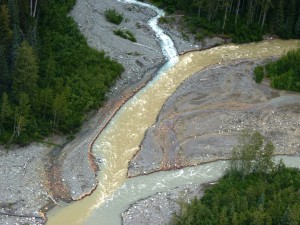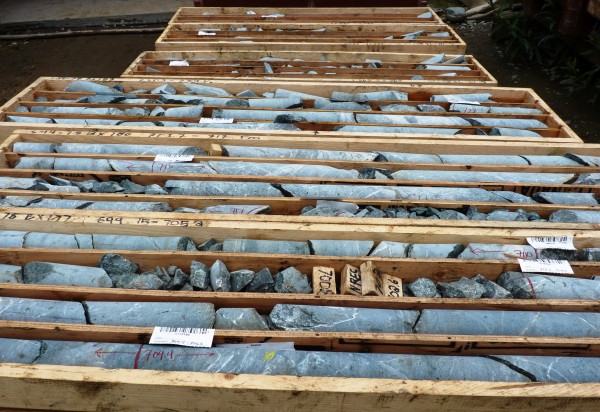Gold nuggets in mines are not just a thing of the past. Fire Creek gold mine is one of the few mines in the world that can boast visible gold ore. The Fire Creek property is located in north central Nevada
The
underground mine is in Lander County and is about seven miles northwest
of Crescent Valley. The mine is owned by Klondex Mines Ltd.
Klondex
acquired the Fire Creek property in 1975. From that time until 1999,
Klondex had leased the property to four different companies, said Fire
Creek Mine Manager Mike Isaak. Those companies did various stages of
exploration. One of the companies even did a production heap leach test,
but that didn’t prove out very well due to the nugget effect of the
ore, Isaak said.
Klondex didn’t become “serious” about the property until 2004, he said.
“Over
a short period of time they drilled 360,000 feet of drilling, which was
all done from the surface at that time,” Isaak said.
The
Fire Creek underground project was started in April 2011. Prior to
that, people thought the mine would be a surface mine, but a change in
leadership at the company was a turning point for how the mine was
conceived, Isaak said.
“Paul Huet became CEO in September of 2012,” he said. “That was really a turning point for Klondex and for Fire Creek.”
In March 2014, Klondex announced the mine had 717,000 ounces of measured and indicated resources available.
“That started to get some people really excited about what’s the potential of Fire Creek,” Isaak said.
After
that, the property’s next milestone was a gold pour, which was made
possible when Klondex bought the Midas Mine in Elko County from Newmont
Mining Corp.
“All the material that we produce is processed at Midas,” Isaak said.
Production Fire Creek gold mine Nevada
Joyce,
Vonnie and Karen are the “premier veins” in Fire Creek, Isaak said.
These veins are the main sources for the ore. The site plans on mining
about 76,000 ounces of gold this year, he said.
The fourth vein is Hui Wu, said Fire Creek Chief Geologist John Marma.
“They’re all banded high-grade veins, the result of an epithermal vein system,” he said. “The grades speak for themselves.”
The
Joyce Vein is 5.481 ounces per ton over 1.7 feet and the diluted grade
is 1.422 opt over slightly more than 7 feet at particular faces, Marma
said. He also went through select faces of the other veins: Vonnie is 1
foot of 80.056 opt and the diluted grade is 25.213 opt over slightly
more than three feet. Karen is 2.5 feet at 8.324 opt and the diluted
grade is 3.299 opt over 6.4 feet. The Hui Wu Vein is 5 opt over 1 foot.
Marma said the mine has “bonanza grades” because it is an epithermal system.
“It’s
very typical of these systems,” he said. “With those bonanza grades we
have seen upwards of 800 to 900 ounces per ton in some faces. … It’s a
really well developed deposit and we expect to be here for awhile.”
An
epithermal system is normally narrow, high grade and typically
underground, he said. To mine the ore, they need to mill it. When asked
to describe the type of ore in the mine, Marma said none of the ore is
refractory or oxide. He said 60 percent is done on the course portion of
the mill, because it still is found in nugget or visible form.
Part of the reason visible gold is found at Fire Creek is because the site wasn’t touched in the 1800s, Marma said.
“We’re mining high volume at quality tons,” he said.
The
mine and the veins are open in all directions, Marma said. For example,
the Joyce Vein has been mined for a quarter mile, but the end has not
been reached yet.
“The
property is grossly under-explored,” Marma said. “Only 2 to 3 percent
has been mapped. The mineralization goes all the way to the surface but
we haven’t found the end yet.”
Fire
Creek is the highest grade gold producer in the world. According to
mining.com, Fire Creek’s average grade is 1.5 ounces per ton. The next
closest underground operation is Macassa Mine in Canada and it has an
average grade of 0.77 opt. Turquoise Ridge Joint Venture, owned by
Barrick Gold Corp. and Newmont Mining Corp., has the most reserves in
tons for an underground gold mine, but its average grade is 0.59 opt.
The diluted grades for the Karen Vein ranged from 1 opt to 5 opt, Marma said.
“It was kind of a surprise,” he said. “She’s been a good vein.”
The
veins consist of quartz, calcite and gold and silver. The host rock of
the veins is basalt. Marma said the basalt holds a fracture open well
and is a competent rock host. This means the mine needs very little
shotcrete.
All of the ore at Fire Creek has been mined through cut-and-fill method, Isaak said.
“We’re transitioning to long-hole mining or open stoping,” he said.
The
miners use jackleg and mechanized drills. The development mining is
done with a mechanized drill and a lot of the vein mining is done with
jackleg drills.
“We’re
pretty excited about the transition,” Isaak said about changing to open
stoping. “It will help lower costs. We won’t be able to do it
everywhere, but where we can, we will.”
Employees Fire Creek gold mine Nevada
The staff as Fire Creek is mostly veterans of the mining industry.
Isaak
came to Fire Creek in June 2014. He has 40 years of mining experience
and has worked in underground mines all over the world throughout his
career.
Marma
has 17 years of underground and surface geology experience. He was
hired by Klondex in January 2014. He worked previously for Newmont at
the Midas Mine.
Doug
Crawford has worked in the mining industry for 34 years. He has worked
mostly underground and was hired to work at Fire Creek in December 2013.
Rob
Crommelin is the senior safety manager and has worked in the industry
for 14 years. Ten of those have been spent underground.
Fanuel Banda has 11 years of experience and most of that has been spent underground. He has worked in the U.S. and in Zambia.
Mike Baum has been in the mining industry for 22 years.
“We’ve
pulled together quite a talent pool,” Isaak said. “Of the people that
we just introduced, we have 135 years of mining experience here at this
site. That’s very comforting for myself, as a mine manager, to know that
we have that level of experience here, and we truly have people that
are passionate about safety and making this property very successful.”
The
site has 42 hourly and 21 salaried employees. Klondex started mining
the site with a contractor, but took over operations in the early part
of 2014. The company also has offices in Reno, Winnemucca and Elko. The
property does have about 31 contractors who perform drilling,
maintenance and security. The drilling on the surface and underground is
done by American Drilling.
“It puts us just under 100 people on a regular basis,” Isaak said.
He
said all the employees are proud of the site’s safety record. Last year
it was awarded the safest small underground mine in the state for 2013.
“On
the heels of that, in October of last year, Fire Creek had achieved two
years of lost time free,” Isaak said. “We are currently at over a
thousand days and will be celebrating three years of lost time free in
October again this year. … In the mining industry that’s not easy to
accomplish.”













































